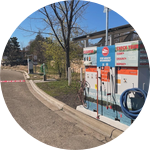About This Project
Post Deepwater Horizon oil spill, there has been much interest in planning, evaluating, and mitigating the impacts of the mid-Barataria Sediment Diversion project on the ecosystems and dolphins in particular. For this project, NOAA SEFSC and Nucleic Sensing Systems are partnering to pilot an autonomous, continuous sampling, in-field, free eDNA digital droplet PCR instrument for an alternative detecting method for bottlenose dolphins.
Ask the Scientists
Join The DiscussionWhat is the context of this research?
The Deepwater Horizon oil spill devastated the Gulf of Mexico off the coast of Louisiana. The bottlenose dolphin is a significant species to monitor both from an ecological perspective and in light of the Marine Mammals Protection Act. However, traditional methods for monitoring and sight counts lack the broader scientific rigor needed to truly assess recovery. These methods largely use "spotters" to visually identify and quantify bottlenose dolphins. Additionally, they employ typical eDNA methods of sample collection, stabilization, and sending to a laboratory for analysis. However, this does not provide the quantity of data nor meet the agency's goals for sample to answer.
What is the significance of this project?
This project will be the first of its kind to have a continuous in-field sampling of bottlenose dolphin eDNA. It will show the efficacy of a ddPCR to monitor eDNA in the field that can show changes in eDNA concentrations of a species of concern. As an apex predator dolphin populations will be emblematic of the broader ecosystem health. By quantifying their eDNA in real-time, they can monitor and report on dolphin population changes and correlate them to restoration efforts funded by the Deepwater Horizon recovery funds.
What are the goals of the project?
The project aims to assess the efficacy of ddPCR in quantifying the eDNA of bottlenose dolphins in the field as a surrogate for population and ecosystem recovery. While eDNA concentrations are a very important piece of understanding ecosystem and species population health, there is not necessarily a direct correlation between genetic abundance and populations. Therefore this will research compare a site with known bottlenose dolphin populations (San Diego), with those of unknown bottlenose dolphin populations and it will do so over time. While we are unlikely unequivocally correlate gene concentration to population abundance, the picture will become much clearer.
Budget
While NOAA is covering the cost of the primers, probes, and fluorinated oils for the deployments, they are not covering the cost of benchtop testing materials. This budget will allow us to conduct the necessary testing for the project.
Endorsed by
 Project Timeline
Project Timeline
The project will be a one-year project. Six months for technology development and assay assessment followed by two month-long deployments and subsequent data analysis and report writing.
Sep 03, 2024
Project Launched
Mar 12, 2025
Update Tracker Technology for field deployment
Apr 16, 2025
First field deployment: Gulf of Mexico
May 01, 2025
Second field deployment
Jul 01, 2025
Final report
Meet the Team
Edgar Rudberg
Dr. Rudberg's career has focused on developing innovative technologies in conservation. He has brought multiple products to market and grown them to international distribution. He has a Ph.D. in Natural Resources and Conservation from the University of Minnesota.
Lab Notes
Nothing posted yet.
Project Backers
- 1Backers
- 1%Funded
- $5Total Donations
- $5.00Average Donation

